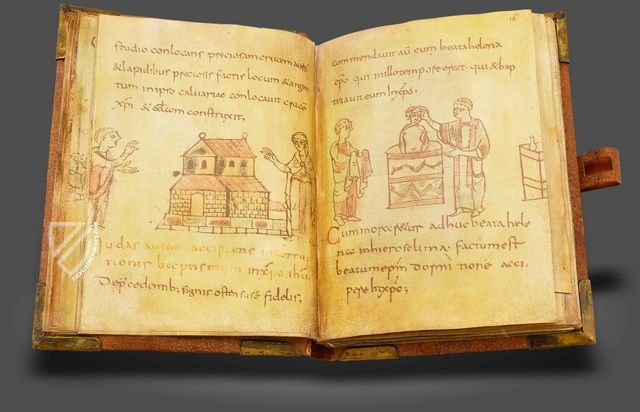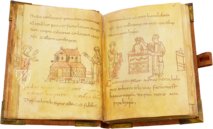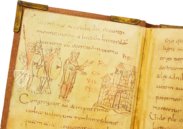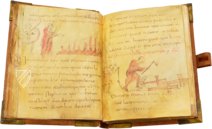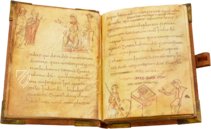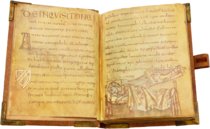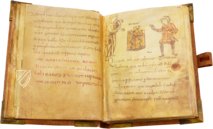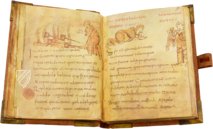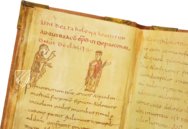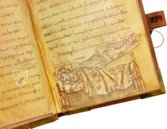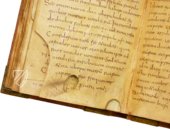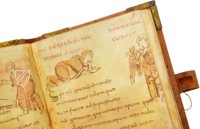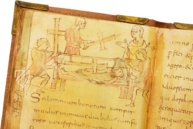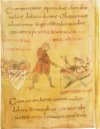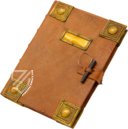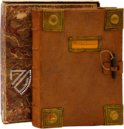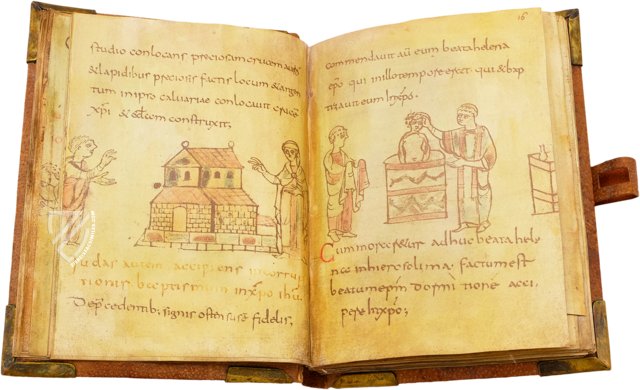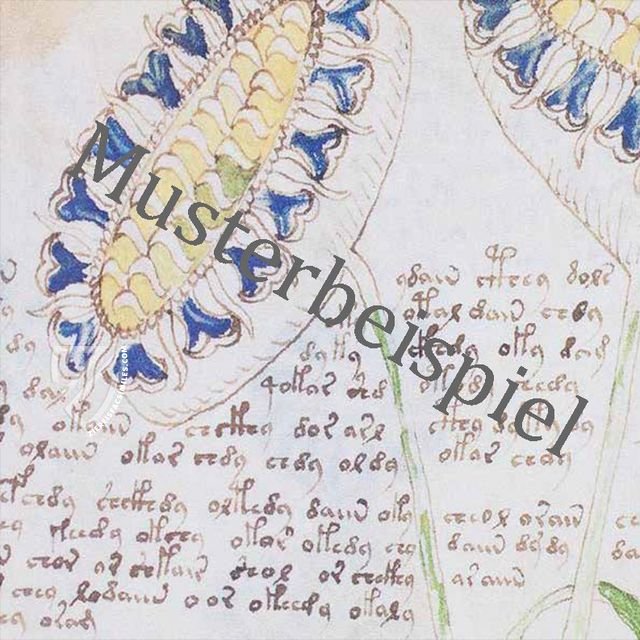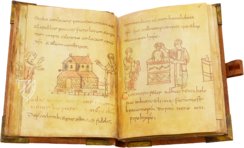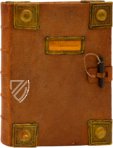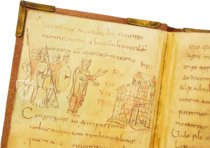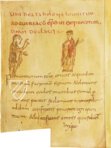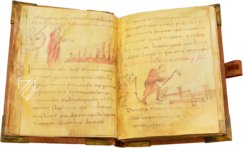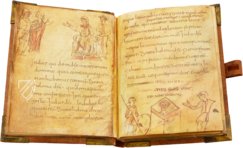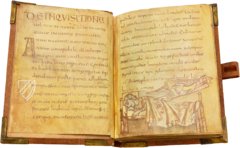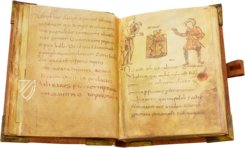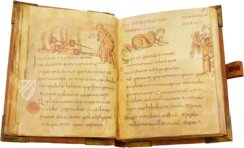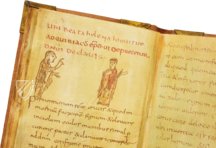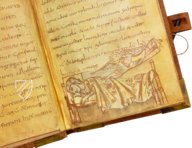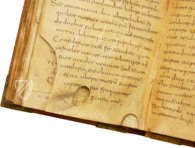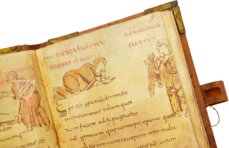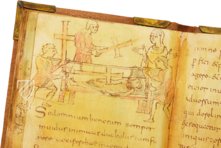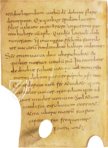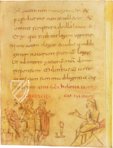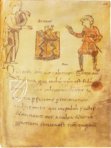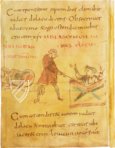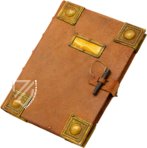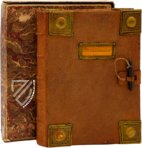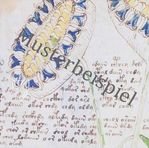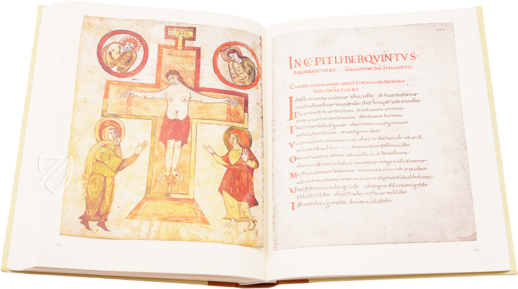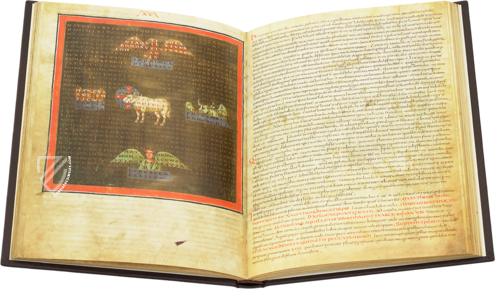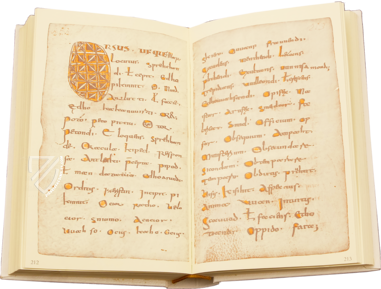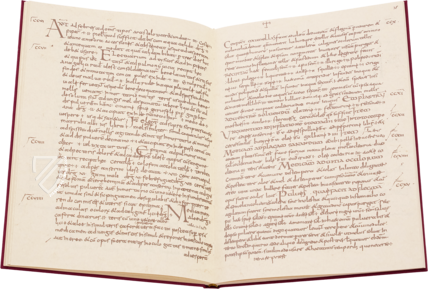Wessobrunn Prayer
(1,000€ - 3,000€)
This manuscript contains the Wessobrunner Gebet or Prayer of Wessobrunn and 70 other short, mainly theological texts. The prayer itself, in prose, which gives the text as a whole its name, is preceded by a short creation poem, which, in nine lines of alliterative verse, seeks to explain the creation of the world out of chaos. This small literary monument is among the earliest written examples of poetry in Old High German and is found of a composite manuscript mainly written in Latin ca. 814, which can be determined from a mention of the death of Charlemagne on the last page. The manuscript is also significant for the history of German illumination, containing 18 half-page miniatures concerning the legend of the True Cross, which represent one of the earliest picture cycles of non-biblical content in the history of German illumination.
Wessobrunn Prayer
The Wessobrunner Gebet or Wessobrunn Prayer is one of the oldest examples of Old High German poetry and was likely written in the late 8th century. It was inserted into a Latin manuscript sometime after 800 on fol. 65v-66r and is divided into two parts: a short text of nine incomplete verses of staff rhyme written in alliterative verse, and the actual prayer in freely rhythmic prose. The fragment of a creation myth is also the oldest surviving piece of Christian stave rhyme poetry. It contrasts the chaos before Creation with almighty God in the circle of his angels. An unknown monk decided to incorporate the German poem into a Latin compendium of ca. 70 texts divided into five parts ca. 814.
Artifact of the German Language
Judging by the Bavarian dialect in which it was written, which exhibits some Swabian influences, it was likely created in the Diocese of Augsburg, but probably not at Wessobrunn Abbey. Research suggests that the manuscript could have originated in either Regensburg, Benediktbeuern, Staffelsee, or Augsburg itself. Interestingly, there are also some influences from Low German and Anglo-Saxon, such as the scribe’s incorporation of a “star-rune” in the first line of the poem. The work has survived under the title De poeta as the only larger German text in the Latin manuscript, the rest of which consists of texts that are mostly theological, but also geographical and chronological in nature, and are written down in Carolingian minuscule.
The Legend of the True Cross
Folios 1v −21r contain the legend of the True Cross, which is illustrated by 18 half-page miniatures. The pen and ink drawings, which also likely originate from Bavaria, are simple, have restrained coloring, and represent one of the earliest picture cycles of non-biblical content in the history of German illumination. This is the oldest preserved picture cycle concerning Emperor Constantine the Great (ca. 272-337) and his mother Helena. According to legend, the Emperor’s mother had the pagan temple that had been built over the site of the Holy Sepulchre destroyed so that a Christian church might replace it. During the demolition, three crosses, the Titulus Crucis with the inscription “Here is the king of the Jews”, and the nails used to crucify Jesus were uncovered. The three crosses were brought to a to a dead man, who was awakened by the touch of the third cross, which was thus believed to be the cross of Christ. Helena then had these relics sent to Constantinople.
Codicology
- Alternative Titles
- Prayer of Wessobrunn
Wessobrunner Gebet
Wessobronner Gebet
Wessobrunner Schöpfungsgedicht
Liber de inventione s. crucis - Size / Format
- 198 pages / 18.5 × 14.1 cm
- Origin
- Germany
- Date
- About 814
- Epochs
- Style
- Script
- Carolingian minuscule
- Illustrations
- 18 half-page pen drawings
- Content
- The Wessobrunn Prayer (fol. 65v-66r) written in the Bavarian language is the only larger German text in the otherwise Latin collective manuscript, which compiles more than seventy texts of a mostly theological, but also geographic and chronological nature
Wessobrunn prayer
A raising of the dead proves the true cross
Two bearers have brought a man in the deathbed to Helena, back right, for the "trial of the cross". A third helper touches the corpse with the first two crosses, which have no effect. However, the half-page miniature also shows the "True Cross" which, according to legend, is the last to be tried and brings the dead person back to life. It stands erect on the left side, waiting to perform the miracle. Accordingly, the image, in contrast to the text, does not emphasize the miracle itself, but the way to it.
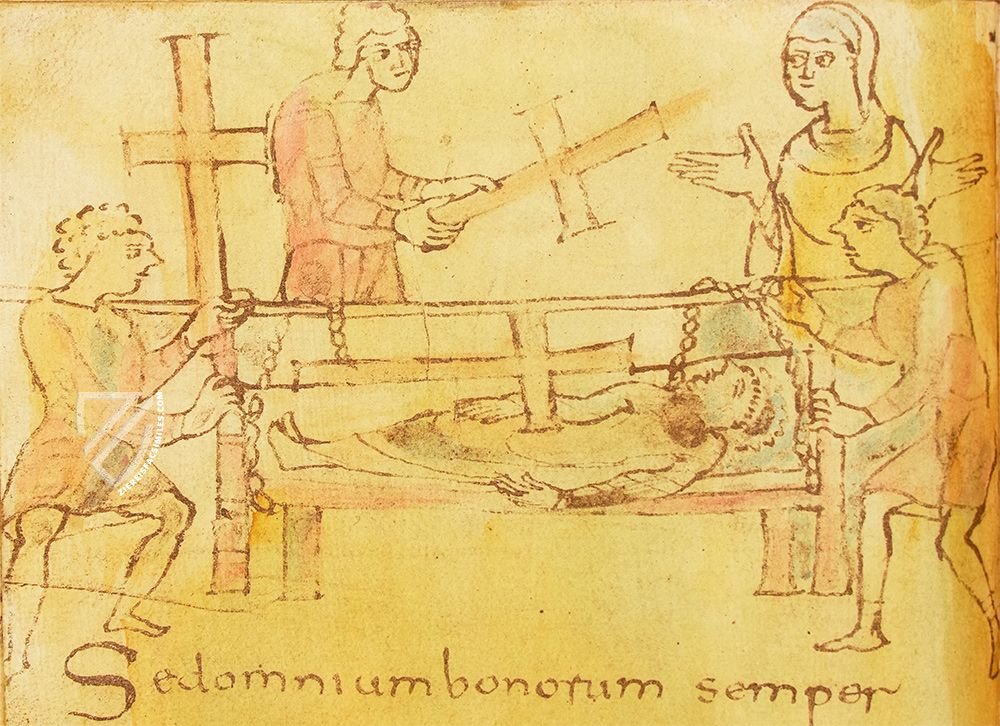
Wessobrunn Prayer
The Baptism of Judas Quiriacus
Legend says that Judas, commissioned by Helena, found both the three crosses of Golgotha and the nails with which Jesus was crucified. Impressed by the miracle of the awakening of a dead performed with the cross, he decided to be baptized with the name of Judas Quiriacus, or Cyriacus, and eventually even became the bishop of Jerusalem. In the picture cycle of the legend of the finding of the True Cross, he constantly appears in all three roles.
On this page, Judas' baptism is depicted according to the early Christian rite: The baptized stands humbly in a deep baptismal font while the bishop pours the consecrated water over him. The speech gesture of his left hand indicates the ritual words he addresses to the baptized. On the right edge of the picture there is also an ointment vessel on a table, with the content of which the presbyter on the left side has probably anointed the body of the baptized before the baptism.
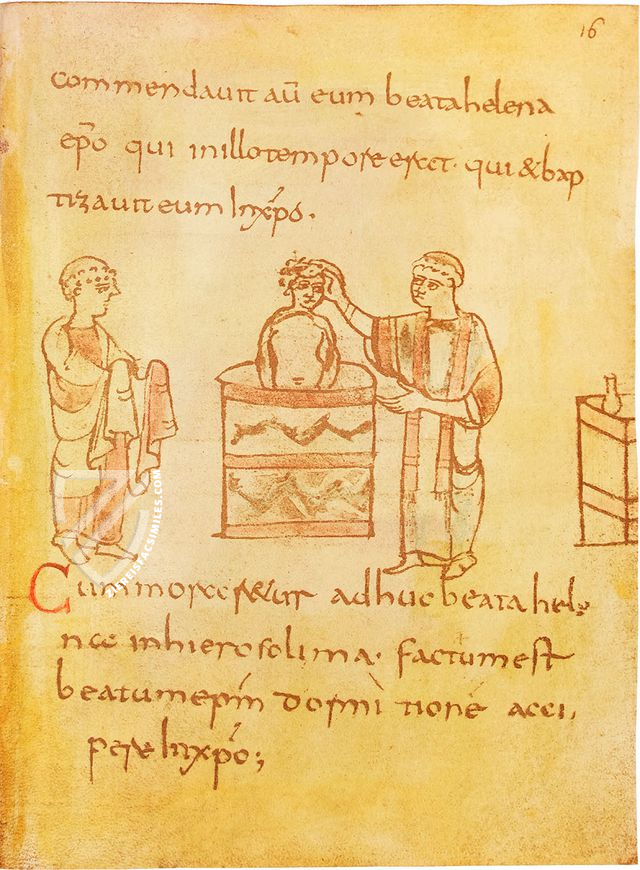
#1 Wessobrunner Gebet
Language: German
(1,000€ - 3,000€)
#2 Codex Wessobrunn
Language: German
- Treatises / Secular Books
- Apocalypses / Beatus
- Astronomy / Astrology
- Bestiaries
- Bibles / Gospels
- Chronicles / History / Law
- Geography / Maps
- Saints' Lives
- Islam / Oriental
- Judaism / Hebrew
- Single Leaf Collections
- Leonardo da Vinci
- Literature / Poetry
- Liturgical Manuscripts
- Medicine / Botany / Alchemy
- Music
- Mythology / Prophecies
- Psalters
- Other Religious Books
- Games / Hunting
- Private Devotion Books
- Other Genres
- Afghanistan
- Armenia
- Austria
- Belgium
- Belize
- Bosnia and Herzegovina
- China
- Colombia
- Costa Rica
- Croatia
- Cyprus
- Czech Republic
- Denmark
- Egypt
- El Salvador
- Ethiopia
- France
- Germany
- Greece
- Guatemala
- Honduras
- Hungary
- India
- Iran
- Iraq
- Israel
- Italy
- Japan
- Jordan
- Kazakhstan
- Kyrgyzstan
- Lebanon
- Liechtenstein
- Luxembourg
- Mexico
- Morocco
- Netherlands
- Palestine
- Panama
- Peru
- Poland
- Portugal
- Romania
- Russia
- Serbia
- Spain
- Sri Lanka
- Sweden
- Switzerland
- Syria
- Tajikistan
- Turkey
- Turkmenistan
- Ukraine
- United Kingdom
- United States
- Uzbekistan
- Vatican City
- A. Oosthoek, van Holkema & Warendorf
- Aboca Museum
- Ajuntament de Valencia
- Akademie Verlag
- Akademische Druck- u. Verlagsanstalt (ADEVA)
- Aldo Ausilio Editore - Bottega d’Erasmo
- Alecto Historical Editions
- Alkuin Verlag
- Almqvist & Wiksell
- Amilcare Pizzi
- Andreas & Andreas Verlagsbuchhandlung
- Archa 90
- Archiv Verlag
- Archivi Edizioni
- Arnold Verlag
- ARS
- Ars Magna
- ArtCodex
- AyN Ediciones
- Azimuth Editions
- Badenia Verlag
- Bärenreiter-Verlag
- Belser Verlag
- Belser Verlag / WK Wertkontor
- Benziger Verlag
- Bernardinum Wydawnictwo
- BiblioGemma
- Biblioteca Apostolica Vaticana (Vaticanstadt, Vaticanstadt)
- Bibliotheca Palatina Faksimile Verlag
- Bibliotheca Rara
- Boydell & Brewer
- Bramante Edizioni
- Bredius Genootschap
- Brepols Publishers
- British Library
- C. Weckesser
- Caixa Catalunya
- Canesi
- CAPSA, Ars Scriptoria
- Caratzas Brothers, Publishers
- Carus Verlag
- Casamassima Libri
- Centrum Cartographie Verlag GmbH
- Chavane Verlag
- Christian Brandstätter Verlag
- Circulo Cientifico
- Club Bibliófilo Versol
- Club du Livre
- CM Editores
- Collegium Graphicum
- Collezione Apocrifa Da Vinci
- Comissão Nacional para as Comemorações dos Descobrimentos Portugueses
- Coron Verlag
- Corvina
- CTHS
- D. S. Brewer
- Damon
- De Agostini/UTET
- De Nederlandsche Boekhandel
- De Schutter
- Deuschle & Stemmle
- Deutscher Verlag für Kunstwissenschaft
- DIAMM
- Droz
- E. Schreiber Graphische Kunstanstalten
- Ediciones Boreal
- Ediciones Grial
- Ediclube
- Edições Inapa
- Edilan
- Editalia
- Edition Deuschle
- Edition Georg Popp
- Edition Leipzig
- Edition Libri Illustri
- Editiones Reales Sitios S. L.
- Éditions de l'Oiseau Lyre
- Editions Medicina Rara
- Editorial Casariego
- Editorial Mintzoa
- Editrice Antenore
- Editrice Velar
- Edizioni Edison
- Egeria, S.L.
- Eikon Editores
- Electa
- Emery Walker Limited
- Enciclopèdia Catalana
- Eos-Verlag
- Ephesus Publishing
- Ernst Battenberg
- Eugrammia Press
- Extraordinary Editions
- Fackelverlag
- Facsimila Art & Edition
- Facsimile Editions Ltd.
- Facsimilia Art & Edition Ebert KG
- Faksimile Verlag
- Feuermann Verlag
- Folger Shakespeare Library
- Franco Cosimo Panini Editore
- Friedrich Wittig Verlag
- Fundación Hullera Vasco-Leonesa
- G. Braziller
- Gabriele Mazzotta Editore
- Gebr. Mann Verlag
- Gesellschaft für graphische Industrie
- Getty Research Institute
- Giovanni Domenico de Rossi
- Giunti Editore
- Graffiti
- Grafica European Center of Fine Arts
- Guido Pressler
- Guillermo Blazquez
- Gustav Kiepenheuer
- H. N. Abrams
- Harrassowitz
- Harvard University Press
- Helikon
- Hendrickson Publishers
- Henning Oppermann
- Herder Verlag
- Hes & De Graaf Publishers
- Hoepli
- Holbein-Verlag
- Houghton Library
- Hugo Schmidt Verlag
- Idion Verlag
- Il Bulino, edizioni d'arte
- ILte
- Imago
- Insel Verlag
- Insel-Verlag Anton Kippenberger
- Instituto de Estudios Altoaragoneses
- Instituto Nacional de Antropología e Historia
- Introligatornia Budnik Jerzy
- Istituto dell'Enciclopedia Italiana - Treccani
- Istituto Ellenico di Studi Bizantini e Postbizantini
- Istituto Geografico De Agostini
- Istituto Poligrafico e Zecca dello Stato
- Italarte Art Establishments
- Jan Thorbecke Verlag
- Johnson Reprint Corporation
- Josef Stocker
- Josef Stocker-Schmid
- Jugoslavija
- Karl W. Hiersemann
- Kasper Straube
- Kaydeda Ediciones
- Kindler Verlag / Coron Verlag
- Kodansha International Ltd.
- Konrad Kölbl Verlag
- Kurt Wolff Verlag
- La Liberia dello Stato
- La Linea Editrice
- La Meta Editore
- Lambert Schneider
- Landeskreditbank Baden-Württemberg
- Leo S. Olschki
- Les Incunables
- Liber Artis
- Library of Congress
- Libreria Musicale Italiana
- Lichtdruck
- Lito Immagine Editore
- Lumen Artis
- Lund Humphries
- M. Moleiro Editor
- Maison des Sciences de l'homme et de la société de Poitiers
- Manuscriptum
- Martinus Nijhoff
- Maruzen-Yushodo Co. Ltd.
- MASA
- Massada Publishers
- McGraw-Hill
- Metropolitan Museum of Art
- Militos
- Millennium Liber
- Müller & Schindler
- Nahar - Stavit
- Nahar and Steimatzky
- National Library of Wales
- Neri Pozza
- Nova Charta
- Oceanum Verlag
- Odeon
- Orbis Mediaevalis
- Orbis Pictus
- Österreichische Staatsdruckerei
- Oxford University Press
- Pageant Books
- Parzellers Buchverlag
- Patrimonio Ediciones
- Pattloch Verlag
- PIAF
- Pieper Verlag
- Plon-Nourrit et cie
- Poligrafiche Bolis
- Presses Universitaires de Strasbourg
- Prestel Verlag
- Princeton University Press
- Prisma Verlag
- Priuli & Verlucca, editori
- Pro Sport Verlag
- Propyläen Verlag
- Pytheas Books
- Quaternio Verlag Luzern
- Reales Sitios
- Recht-Verlag
- Reichert Verlag
- Reichsdruckerei
- Reprint Verlag
- Riehn & Reusch
- Roberto Vattori Editore
- Rosenkilde and Bagger
- Roxburghe Club
- Salerno Editrice
- Saltellus Press
- Sandoz
- Sarajevo Svjetlost
- Schöck ArtPrint Kft.
- Schulsinger Brothers
- Scolar Press
- Scrinium
- Scripta Maneant
- Scriptorium
- Shazar
- Siloé, arte y bibliofilia
- SISMEL - Edizioni del Galluzzo
- Sociedad Mexicana de Antropología
- Société des Bibliophiles & Iconophiles de Belgique
- Soncin Publishing
- Sorli Ediciones
- Stainer and Bell
- Studer
- Styria Verlag
- Sumptibus Pragopress
- Szegedi Tudomànyegyetem
- Taberna Libraria
- Tarshish Books
- Taschen
- Tempus Libri
- Testimonio Compañía Editorial
- Thames and Hudson
- The Clear Vue Publishing Partnership Limited
- The Facsimile Codex
- The Folio Society
- The Marquess of Normanby
- The Richard III and Yorkist History Trust
- Tip.Le.Co
- TouchArt
- TREC Publishing House
- TRI Publishing Co.
- Trident Editore
- Tuliba Collection
- Typis Regiae Officinae Polygraphicae
- Union Verlag Berlin
- Universidad de Granada
- University of California Press
- University of Chicago Press
- Urs Graf
- Vallecchi
- Van Wijnen
- VCH, Acta Humaniora
- VDI Verlag
- VEB Deutscher Verlag für Musik
- Verlag Anton Pustet / Andreas Verlag
- Verlag Bibliophile Drucke Josef Stocker
- Verlag der Münchner Drucke
- Verlag für Regionalgeschichte
- Verlag Styria
- Vicent Garcia Editores
- W. Turnowski Ltd.
- W. Turnowsky
- Waanders Printers
- Wiener Mechitharisten-Congregation (Wien, Österreich)
- Wissenschaftliche Buchgesellschaft
- Wissenschaftliche Verlagsgesellschaft
- Wydawnictwo Dolnoslaskie
- Xuntanza Editorial
- Zakład Narodowy
- Zollikofer AG

